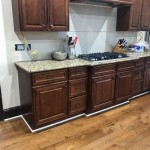Can I Paint Over Stained Kitchen Cabinets?
Stained kitchen cabinets add character and warmth to your kitchen, but as styles change and personal preferences evolve, you may consider updating their look. Painting over stained kitchen cabinets is an excellent way to refresh your kitchen's aesthetics and match it to your evolving taste. However, it's essential to note that painting over stained cabinets requires proper preparation and technique to ensure a successful and durable finish.
Before embarking on this project, consider the following essential aspects to achieve a professional-looking and long-lasting result:
1. Evaluate the Condition of the Cabinets
Assess the condition of your stained cabinets. Check for any signs of damage, such as scratches, dents, or warping. If the cabinets are severely damaged, it may be necessary to replace them instead of painting over them.
2. Clean and Degrease the Cabinets
Thoroughly clean the cabinets to remove any dust, grease, or grime. Use a strong cleaning solution, such as a mixture of TSP (trisodium phosphate) and water. After cleaning, allow the cabinets to dry completely. Removing all residue will ensure the paint adheres properly.
3. Sand the Cabinets
Lightly sand the cabinets with a fine-grit sandpaper (120-grit or higher). The sanding helps create a smooth surface for the paint to adhere to. Use a sanding block for a more controlled and even finish.
4. Prime the Cabinets
Applying a primer is crucial to create a barrier between the stain and the paint. Choose a primer specifically designed for kitchen cabinets, as they typically contain additives to enhance adhesion. Apply one or two coats of primer, allowing each coat to dry completely before applying the next.
5. Choose the Right Paint
Select a paint that is specifically designed for kitchen cabinets. These paints are formulated to withstand regular use, cleaning, and moisture, ensuring a durable finish. Use a semi-gloss or satin finish for easy cleaning and a professional-looking result.
6. Apply the Paint
Apply the first coat of paint using a brush or foam roller. Use even strokes and work in the direction of the wood grain. Allow the first coat to dry completely before applying a second coat. For a smooth and durable finish, sand lightly between coats using a fine-grit sandpaper (220-grit or higher).
7. Seal the Cabinets
Once the paint is completely dry, apply a clear sealant to protect the cabinets from scratches, stains, and moisture. Choose a sealant designed for kitchen cabinets, as they offer additional protective qualities. Apply one or two coats of sealant, allowing each coat to dry thoroughly before using the cabinets.
8. Reinstall Hardware and Enjoy
Reinstall the cabinet doors, drawers, and hardware. Clean up any paint spills or residue. Your newly painted kitchen cabinets are ready to enjoy!
Remember, while painting over stained kitchen cabinets may seem like a daunting task, following these essential steps will help you achieve a professional and durable finish. Thorough preparation and proper technique will ensure your kitchen cabinets look their best for years to come.

Can I Paint Over Stained Wood Williams Painting

Can I Paint Over Stained Wood Williams Painting

Avoid These Mistakes How To Paint Cabinets That Are Already Painted Grace In My Space

Steps In Painting Kitchen Cabinets That Are Stained Restoring

Cabinet Refinishing Guide

How To Paint Kitchen Cabinets In 7 Simple Steps

How To Paint Veneer Cabinets For A Long Lasting Finish Anika S Diy Life

How To Paint Kitchen Cabinets A Step By Guide Confessions Of Serial Do It Yourselfer

Painting Dark Kitchen Cabinets White My Weathered Home

Tips Tricks To Paint Honey Oak Kitchen Cabinets Cottage Living And Style
Related Posts








